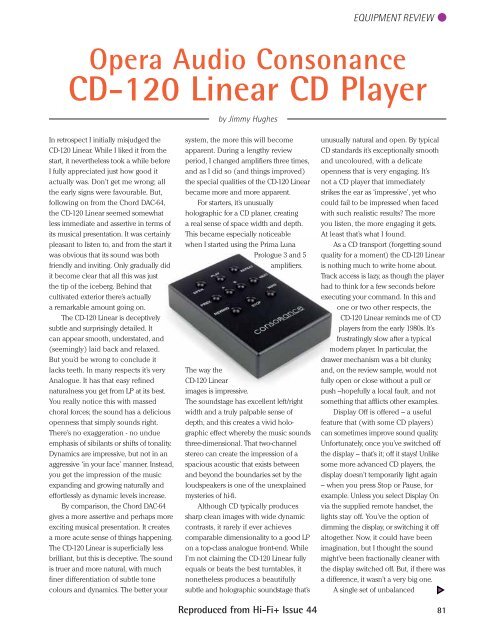Opera Audio Consonance CD-120 Linear CD Player - Alium Audio
Opera Audio Consonance CD-120 Linear CD Player - Alium Audio
Opera Audio Consonance CD-120 Linear CD Player - Alium Audio
Create successful ePaper yourself
Turn your PDF publications into a flip-book with our unique Google optimized e-Paper software.
system, the more this will become<br />
apparent. During a lengthy review<br />
period, I changed amplifiers three times,<br />
and as I did so (and things improved)<br />
the special qualities of the <strong>CD</strong>-<strong>120</strong> <strong>Linear</strong><br />
became more and more apparent.<br />
For starters, it’s unusually<br />
holographic for a <strong>CD</strong> planer, creating<br />
a real sense of space width and depth.<br />
This became especially noticeable<br />
when I started using the Prima Luna<br />
Prologue 3 and 5<br />
amplifiers.<br />
The way the<br />
<strong>CD</strong>-<strong>120</strong> <strong>Linear</strong><br />
images is impressive.<br />
The soundstage has excellent left/right<br />
width and a truly palpable sense of<br />
depth, and this creates a vivid holographic<br />
effect whereby the music sounds<br />
three-dimensional. That two-channel<br />
stereo can create the impression of a<br />
spacious acoustic that exists between<br />
and beyond the boundaries set by the<br />
loudspeakers is one of the unexplained<br />
mysteries of hi-fi.<br />
Although <strong>CD</strong> typically produces<br />
sharp clean images with wide dynamic<br />
contrasts, it rarely if ever achieves<br />
comparable dimensionality to a good LP<br />
on a top-class analogue front-end. While<br />
I’m not claiming the <strong>CD</strong>-<strong>120</strong> <strong>Linear</strong> fully<br />
equals or beats the best turntables, it<br />
nonetheless produces a beautifully<br />
subtle and holographic soundstage that’s<br />
EQUIPMENT REVIEW<br />
<strong>Opera</strong> <strong>Audio</strong> <strong>Consonance</strong><br />
<strong>CD</strong>-<strong>120</strong> <strong>Linear</strong> <strong>CD</strong> <strong>Player</strong><br />
In retrospect I initially misjudged the<br />
<strong>CD</strong>-<strong>120</strong> <strong>Linear</strong>. While I liked it from the<br />
start, it nevertheless took a while before<br />
I fully appreciated just how good it<br />
actually was. Don’t get me wrong; all<br />
the early signs were favourable. But,<br />
following on from the Chord DAC-64,<br />
the <strong>CD</strong>-<strong>120</strong> <strong>Linear</strong> seemed somewhat<br />
less immediate and assertive in terms of<br />
its musical presentation. It was certainly<br />
pleasant to listen to, and from the start it<br />
was obvious that its sound was both<br />
friendly and inviting. Only gradually did<br />
it become clear that all this was just<br />
the tip of the iceberg. Behind that<br />
cultivated exterior there’s actually<br />
a remarkable amount going on.<br />
The <strong>CD</strong>-<strong>120</strong> <strong>Linear</strong> is deceptively<br />
subtle and surprisingly detailed. It<br />
can appear smooth, understated, and<br />
(seemingly) laid back and relaxed.<br />
But you’d be wrong to conclude it<br />
lacks teeth. In many respects it’s very<br />
Analogue. It has that easy refined<br />
naturalness you get from LP at its best.<br />
You really notice this with massed<br />
choral forces; the sound has a delicious<br />
openness that simply sounds right.<br />
There’s no exaggeration - no undue<br />
emphasis of sibilants or shifts of tonality.<br />
Dynamics are impressive, but not in an<br />
aggressive ‘in your face’ manner. Instead,<br />
you get the impression of the music<br />
expanding and growing naturally and<br />
effortlessly as dynamic levels increase.<br />
By comparison, the Chord DAC-64<br />
gives a more assertive and perhaps more<br />
exciting musical presentation. It creates<br />
a more acute sense of things happening.<br />
The <strong>CD</strong>-<strong>120</strong> <strong>Linear</strong> is superficially less<br />
brilliant, but this is deceptive. The sound<br />
is truer and more natural, with much<br />
finer differentiation of subtle tone<br />
colours and dynamics. The better your<br />
by Jimmy Hughes<br />
Reproduced from Hi-Fi+ Issue 44<br />
unusually natural and open. By typical<br />
<strong>CD</strong> standards it’s exceptionally smooth<br />
and uncoloured, with a delicate<br />
openness that is very engaging. It’s<br />
not a <strong>CD</strong> player that immediately<br />
strikes the ear as ‘impressive’, yet who<br />
could fail to be impressed when faced<br />
with such realistic results? The more<br />
you listen, the more engaging it gets.<br />
At least that’s what I found.<br />
As a <strong>CD</strong> transport (forgetting sound<br />
quality for a moment) the <strong>CD</strong>-<strong>120</strong> <strong>Linear</strong><br />
is nothing much to write home about.<br />
Track access is lazy, as though the player<br />
had to think for a few seconds before<br />
executing your command. In this and<br />
one or two other respects, the<br />
<strong>CD</strong>-<strong>120</strong> <strong>Linear</strong> reminds me of <strong>CD</strong><br />
players from the early 1980s. It’s<br />
frustratingly slow after a typical<br />
modern player. In particular, the<br />
drawer mechanism was a bit clunky,<br />
and, on the review sample, would not<br />
fully open or close without a pull or<br />
push –hopefully a local fault, and not<br />
something that afflicts other examples.<br />
Display Off is offered – a useful<br />
feature that (with some <strong>CD</strong> players)<br />
can sometimes improve sound quality.<br />
Unfortunately, once you’ve switched off<br />
the display – that’s it; off it stays! Unlike<br />
some more advanced <strong>CD</strong> players, the<br />
display doesn’t temporarily light again<br />
– when you press Stop or Pause, for<br />
example. Unless you select Display On<br />
via the supplied remote handset, the<br />
lights stay off. You’ve the option of<br />
dimming the display, or switching it off<br />
altogether. Now, it could have been<br />
imagination, but I thought the sound<br />
might’ve been fractionally cleaner with<br />
the display switched off. But, if there was<br />
a difference, it wasn’t a very big one.<br />
A single set of unbalanced<br />
81


